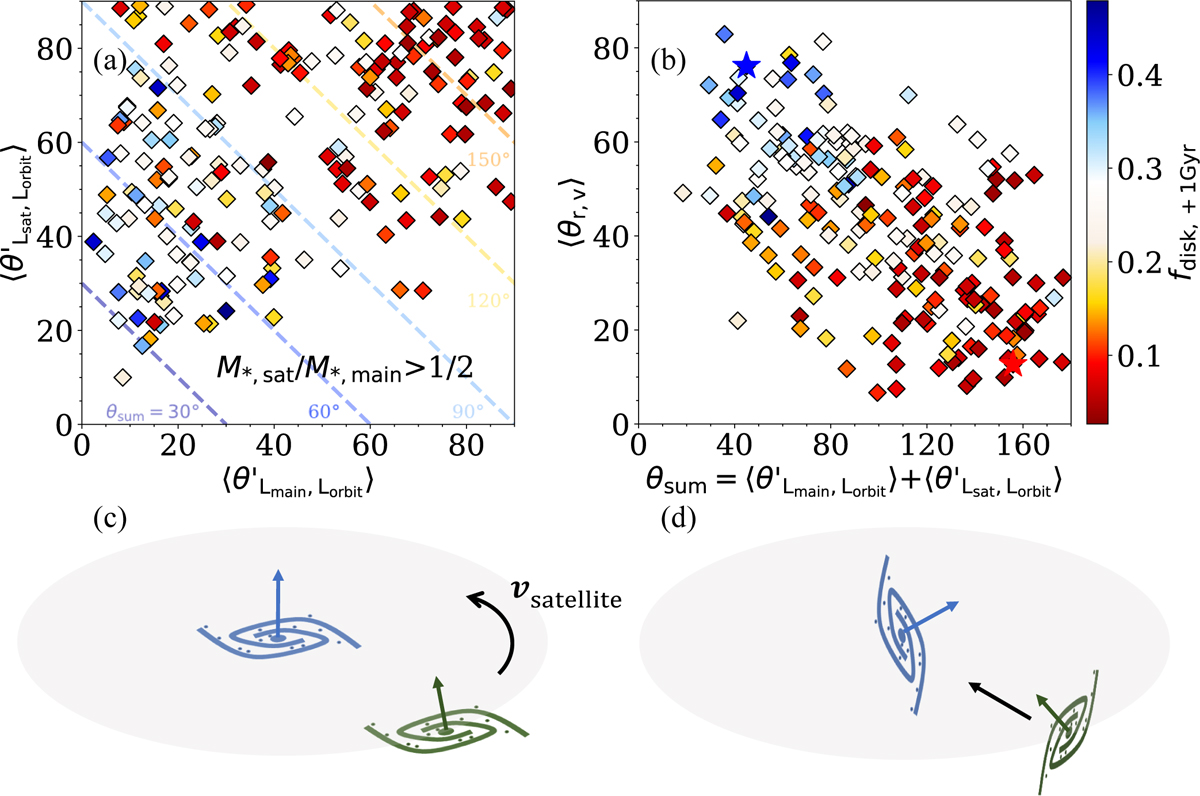Fig. 7

Download original image
Disk fraction in the remnant galaxy (fdisk,+1 Gyr) as a function of ![]() , and ⟨θr, v⟩ for the mergers with mass ratio over 1/2. The dots in panels a and b are colored with fdisk,+1 Gyr. The dashed lines in panel a denote θsum=30°, 60°, 90°, 120°, and 150° from the bottom-left to the top-right. Panels c and d illustrate two extreme cases result in high and low disk fractions in the remnant galaxy. In panel c, both the main progenitor galaxy and the satellite galaxy are aligned parallel to the merger orbital plane, and their orbital configuration is spiral-in, leading to a high disk fraction in the remnant galaxy. In panel d, both the main progenitor galaxy and the satellite galaxy are aligned perpendicular to the merger orbital plane and with a head-on orbit, resulting in a very low disk fraction in the remnant galaxy. For the two typical scenarios represented by panels c and panel d, two samples are selected for display in Appendix C. These two samples are indicated in panel b by a blue star in the upper left corner and a red star in the lower right corner.
, and ⟨θr, v⟩ for the mergers with mass ratio over 1/2. The dots in panels a and b are colored with fdisk,+1 Gyr. The dashed lines in panel a denote θsum=30°, 60°, 90°, 120°, and 150° from the bottom-left to the top-right. Panels c and d illustrate two extreme cases result in high and low disk fractions in the remnant galaxy. In panel c, both the main progenitor galaxy and the satellite galaxy are aligned parallel to the merger orbital plane, and their orbital configuration is spiral-in, leading to a high disk fraction in the remnant galaxy. In panel d, both the main progenitor galaxy and the satellite galaxy are aligned perpendicular to the merger orbital plane and with a head-on orbit, resulting in a very low disk fraction in the remnant galaxy. For the two typical scenarios represented by panels c and panel d, two samples are selected for display in Appendix C. These two samples are indicated in panel b by a blue star in the upper left corner and a red star in the lower right corner.
Current usage metrics show cumulative count of Article Views (full-text article views including HTML views, PDF and ePub downloads, according to the available data) and Abstracts Views on Vision4Press platform.
Data correspond to usage on the plateform after 2015. The current usage metrics is available 48-96 hours after online publication and is updated daily on week days.
Initial download of the metrics may take a while.


